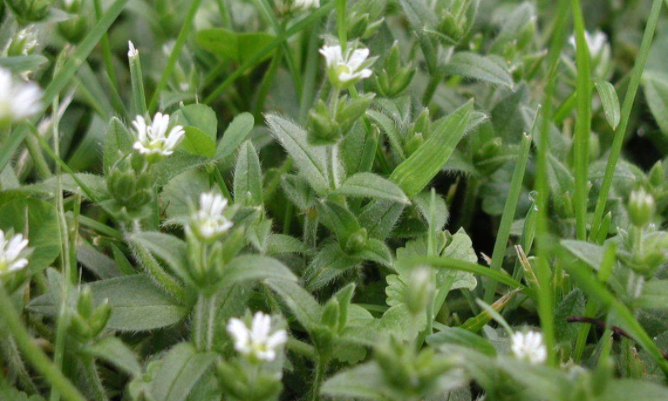Chickweed is an annual weed that’s found in most parts of North America. It forms a thick dense mat that produces small white flowers. This weed has a shallow root system and is best controlled during spring or fall.
There are two main species of chickweed namely common chickweed (Stellaria media) and sticky chickweed (Cerastium glomeratum).
Chickweed can be identified by its white small flowers and lobe-shaped leaves with many stems sprouting from a central point. It’s classified under annual weed that sprouts in the late spring or early summer and dies then dies within a year shortly after flowering.
It normally grows in moist places and in shady areas of lawns and gardens. This weed can be very troublesome if allowed to complete its life cycle.
When left out it will cast out hundreds of seeds in the soil which will become hard for a gardener to get rid of it. It’s advisable to remove it immediately before flowering.
Common chickweed favors areas that are well watered and is known to be a reservoir for most pests, insects, and plant viruses. However, its seeds can be used as chicken food and for other birds.

When does chickweed germinate?
Both common species of chickweed are annual weeds. Their seeds start to germinate from January to early march in cooler regions when the soil temperatures reach 59 Degrees Fahrenheit. However, they thrive in temperatures between 53°F and 68°F.
When the soil is very moist the seeds can germinate at much higher temperatures. The chickweed seeds normally germinate near the soil surface in large numbers after irrigation is carried out or after rain.
When the seeds are buried deeper or the soil within is very dry, it’s more likely that the weed seedlings may not germinate or survive.
Chickweed normally takes 5 to 6 weeks to complete its life cycle and it can have several generations within a year.
How to Get Rid of Chickweed
Chickweed has a very short life cycle and should be controlled at early stages in order to prevent flowering and casting of seeds. Here is how you can get rid of it:
1. Hand weeding or digging
This is done by pulling the weed out of the ground as much as you can. Due to their shallow roots hand pulling or digging is considered the best. After digging make sure you dispose of the weed in a bag to avoid its seeds from dropping to the ground.
2. Smothering with black plastic
This is an effective natural way to get rid of weeds in your lawn. What you need is to weigh down the edges and cover the weed with black plastic or a non-permeable tarp. This works extremely well in lawns invaded by chickweed as it prevents sunlight and air from the weed.
In this method, very little labor is required and the chickweeds are considered dead within a span of 1 to 2 weeks.
3. Spraying with a non-selective weed killer
Nonselective weed killers work within a very short time to give results. What you need is to spray the weed killer carefully to avoid killing your grass. After days the weed will be killed down to the root system. Be sure to read and follow the label instructions.
4. Spraying with selective weed killer
Selective broadleaf weed killers work best on lawns. This kind of weed killer normally kills the chickweed without harming any of the turf grass on the lawn. Do not forget to check the packaging product of the weed killer if it is safe for your turf grass.
5. Mulch your garden
Applying a thick layer of mulch, 2-3 inches will prevent the chickweed from spouting. Mulching normally keeps weed seeds from reaching and also prevents any seed available in the soil from germinating by limiting them from air and sunlight.
6. Till your garden soil
It’s advisable to till your garden soil deep to a depth of six to eight inches to kill any existing chickweed available. It’s always good to till your soil before planting season begins as this will prevent the weeds from spreading.
7. Mow the lawn regularly
Chickweed and any other weeds normally do best when allowed to grow to maturity and to avoid this it’s good to engage in regular mowing. By mowing your lawn weekly you interrupt and keep the chickweed at bay before it matures.
FINAL THOUGHT:
It’s very important to note that chickweed is cultivated by gardeners as a crop. Most preferably is boiled and eaten like spinach which is considered to be very nutritious and tasty. It contains high content of vitamins C and minerals. Chickweed leaves are used as medicine for people with constipation, blood disorders, and stomach and bowel problems. However, in lawns, this plant should be treated as a weed.